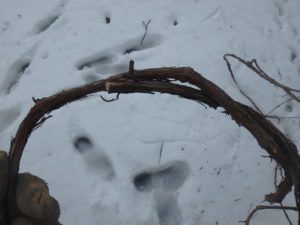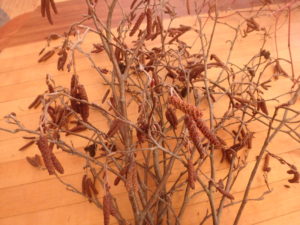How to Make a Spring Wreath
Mud season for many gardeners is bleak. Raw days of gray and rain mean it’s not fun to spend time outdoors, so we wither on the vine. Thankfully, I start lots of seedlings indoors, and early April is the right time to start most vegetables and flowers. But even that doesn’t keep me very busy – and I tend to get squirrelly.
I recently went outside to harvest materials for making a spring wreath, and then made one on the kitchen counter. It perked up my spirits considerably, so I am sharing my technique here – along with some tips about growing what you need for making spring wreathes in years to come.
Here is what you need: several lengths of freshly cut grape vines, each piece 5 to 15 feet long and a quarter to a half an inch in diameter; 25 stems of pussy willows, 25 stems of red-twigged dogwood, and a dozen or so stems of alder with fresh catkins. The stems are all found in moist places alongside the road, or at the edge of a stream or swamp.
Wild grapes are a pest vine for many of us, climbing up trees and strangling them, so pulling some down and using them for a wreath is a good thing to do. Of course this is the time to prune eating and wine grapes, and you may be able to gather enough vines on your domestic plants to make a wreath base.
I went to the woods and cut a 15-foot length of grapevine that was about as thick around as my ring finger. It is important to use living, not dead, vines; the one I cut was a greenish white inside and flexible, so I knew it was alive when I cut it. Dead vines are brittle and not suitable.
To make the wreath form a vine circle 14 to 16 inches in diameter by overlapping (or twisting) one half of the vine over the other half – the same way you would start to tie your shoelaces. Then grasp one of the loose ends and weave it around the vine circle in loops, over and under, pulling it tight as you go. After each piece of vine is in place squeeze the circle to make it regular in shape.
When you run out of vine, tuck the end into the circle and repeat the maneuver with the other end of the vine. Then use shorter, thinner pieces of vine – say 6 to 8 feet long and pencil-thick – and weave them around the wreath base until you have a circle 2 inches or more thick. It’s hard to make a nice round circle of vine, and mine was a little lopsided.
The great thing about this grapevine wreath is that you can just slide stems of pussy willows in between the vines and natural tension will hold them in place. In fact, I had to use a screwdriver to lift the vines at times in order to slide the stems in place.
I went around first with pussy willows stems, poking them into the grape vine base every 4 inches of so. Then I added stems of alders with their nice catkins, and finally I slid in clusters of the red-twigged dogwoods. I hung the wreath up where I could work on it and was better able to see where there were spaces that needed twigs, and added a few more.
A few notes on growing these plants. Pussy willows love to grow in wet places and require no care. You can start them as soon as the ground thaws and the bushes leaf out. Just cut 12-inch branches, strip off the leaves, and push them 8 inches into the soil. They will root where there are leaf nodes.
In addition to growing in the wild, red-twigged dogwood is a nice landscape plant available at any garden center. Stems can grow up to 3 feet in a year, and some gardeners cut the plant right to the ground each spring (once it is a few years old and has well established root systems.) They do that as the stems are most brilliantly colored in their first year of growth. Or you can remove a third of the stems each year, which is what I do.
Alders? They grow wild by my stream and I have to admit I have never seen plants for sale. They are messy plants that tend to flop over and root in. But they are nitrogen-fixing shrubs that will improve the soil in wastelands or alongside the road. I imagine you can root them in the spring just like willows. But they’re not for urban gardeners or small lots.
My wreath is not a professional job, but it pleases me every time I see it. That’s important in mudseason. And after I made mine, we got another foot of snow! March went out like a lion here where I live.
Read Henry’s twice a week blog at www.dailyUV.com. His e-mail is henry.homeyer@comcast.net and you may reach him at PO Box 364, Cornish Flat, NH 03746. Henry’s personal website is www.Gardening-Guy.com.





